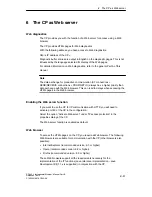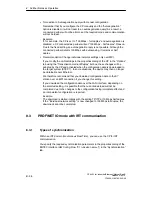
8 Further Notes on Operation
B
−
42
CP 443-1 for Industrial Ethernet / Manual Part B
Release 07/2010
C79000-G8976-C223
−
06
Remedy
The recommendations below will help to avoid these situations:
S
Do not call communication blocks cyclically in OB1!
Communication should be called time-controlled in a suitable cyclic-interrupt
OB. The call interval of this OB should be significantly higher than the average
cycle time of OB1.
S
You should set a minimum cycle time that is higher than the average runtime of
OB1. This frees resources for communication on the CPU. This is, for example,
a remedy for existing applications when communication already takes place
cyclically in OB1.
S
If necessary, reduce the time taken for communication processing on the CPU
by changing the parameters set for “cyclic load due to communication” in the
properties dialog of the CPU.
8.7
SNMP agent
SNMP
(
S
imple
N
etwork
M
anagement
P
rotocol)
The CP supports data queries via SNMP in Version 1. It returns the contents of
certain MIB objects according to the MIB II standard, LLDP MIB and automation
system MIB.
SNMP is a protocol for managing networks. To transmit data, SNMP uses the
connectionless UDP protocol.
The information on the properties of SNMP-compliant devices is entered in MIB
files (MIB = Management Information Base).
Where to find further information
For more detailed information on working with MIB files, refer to the
documentation of the SNMP client you are using (example of an SNMP client:
SNMP OPC Server from SIMATIC NET).
You will find more information on MIB on the following SIMATIC NET Internet
page:
http://support.automation.siemens.com/WW/view/en/15177711
















































